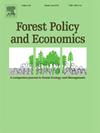Framing forest dieback since 2018 and relating forest restoration: An analysis of the direct communication of forest policy actors in Germany
IF 3.8
2区 农林科学
Q1 ECONOMICS
引用次数: 0
Abstract
Numerous studies have examined the preferred approaches of various actors in Germany regarding the management of degraded forests and forestry under climate change. These studies often portray forestry and nature conservation as opposing perspectives. This paper analyzes the positions of actors from both groups on current forest dieback in Germany by evaluating information on their websites. Using framing theory, the study investigates the perspectives of 27 actors, focusing on diagnostic (e.g., ‘causers’, ‘victims’) and prognostic (e.g., ‘helpers’, ‘instruments’) framing.
The results indicate that different actors frame the current forest dieback in varying ways. Consequently, this paper discusses various options for grouping actors based on their framing. We propose to categorize the actors according to their distinct framing of the identified causers of the current forest dieback and the practical instruments for addressing the damaged forest areas. Two groups can be identified. The first group comprises actors who mention both natural factors and human activities as causers in nearly equal proportions. In terms of instruments, they slightly favor passive approaches over active ones. The second group consists of actors who more frequently cite natural factors than human activities. Regarding instruments, they exclusively mention active approaches. In addition to this dichotomy, approaches involving multiple groups are also discussed. Although only a relatively small number of actors were included in the analysis, the results provide new insights into the complexity of the current discourse surrounding forest dieback.
构建2018年以来森林枯死和相关森林恢复:对德国森林政策行为者直接沟通的分析
许多研究审查了德国各行动者在管理退化森林和气候变化下的林业方面的首选办法。这些研究经常把林业和自然保护描绘成对立的观点。本文通过评估两组参与者网站上的信息,分析了他们对当前德国森林枯死病的立场。利用框架理论,该研究调查了27个行为者的观点,重点关注诊断框架(如“原因”、“受害者”)和预测框架(如“帮助者”、“工具”)。结果表明,不同的参与者以不同的方式构建当前的森林枯死。因此,本文讨论了基于框架对参与者进行分组的各种选项。我们建议根据他们对目前森林枯死的确定原因的独特框架和解决受损森林地区的实际工具对行动者进行分类。可以分为两类。第一类行为者以几乎相等的比例提到自然因素和人类活动都是原因。在工具方面,他们稍微倾向于被动方法而不是主动方法。第二类人更多地引用自然因素,而不是人类活动。关于工具,他们只提到积极的方法。除了这种二分法之外,还讨论了涉及多个群体的方法。虽然分析中只包括相对较少的参与者,但结果为当前围绕森林枯死的讨论的复杂性提供了新的见解。
本文章由计算机程序翻译,如有差异,请以英文原文为准。
求助全文
约1分钟内获得全文
求助全文
来源期刊

Forest Policy and Economics
农林科学-林学
CiteScore
9.00
自引率
7.50%
发文量
148
审稿时长
21.9 weeks
期刊介绍:
Forest Policy and Economics is a leading scientific journal that publishes peer-reviewed policy and economics research relating to forests, forested landscapes, forest-related industries, and other forest-relevant land uses. It also welcomes contributions from other social sciences and humanities perspectives that make clear theoretical, conceptual and methodological contributions to the existing state-of-the-art literature on forests and related land use systems. These disciplines include, but are not limited to, sociology, anthropology, human geography, history, jurisprudence, planning, development studies, and psychology research on forests. Forest Policy and Economics is global in scope and publishes multiple article types of high scientific standard. Acceptance for publication is subject to a double-blind peer-review process.
 求助内容:
求助内容: 应助结果提醒方式:
应助结果提醒方式:


